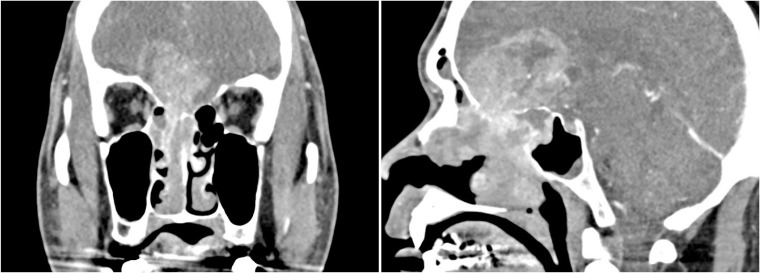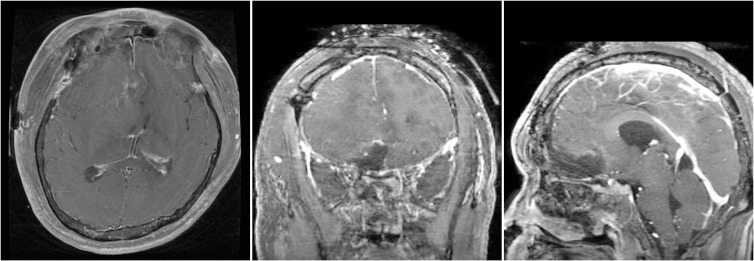Brain Tumor Res Treat.
2020 Apr;8(1):57-61. 10.14791/btrt.2020.8.e2.
Sinonasal Teratocarcinosarcoma, a Rare Tumor Involving Boththe Nasal Cavity and the Cranial Cavity
- Affiliations
-
- 1Departments of Neurosurgery, Kyungpook National University Hospital, Kyungpook National University School of Medicine, Daegu, Korea
- 2Department of Neurosurgery, Kyungpook National University Chilgok Hospital, Kyungpook National University School of Medicine, Daegu, Korea
- 3Departments of Pathology, Kyungpook National University Hospital, Kyungpook National University School of Medicine, Daegu, Korea
- KMID: 2500123
- DOI: http://doi.org/10.14791/btrt.2020.8.e2
Abstract
- Sinonasal teratocarcinosarcoma (SNTCS), a very rare tumor, is known to be a heterogeneous with epithelial, mesenchymal, and neuroepithelial components and shows a very aggressive clinical course. Due to the heterogeneity of this tumor, it is often misdiagnosed. No definitive treatment modality has been reported because it is a very rare tumor. A 44-year-old man presented to a rhinologist with headache and nasal obstruction, and an intranasal tumor was found that invaded into the cranial cavity. He underwent combined surgery with a rhinologist and a neurosurgeon following cognitive decline that worsened after a transnasal biopsy. The patient was diagnosed with SNTCS and underwent radiotherapy. However, residual tumor was found during radiotherapy and additional chemotherapy was administered. Follow-up brain MRI revealed no remnant or recurrent lesion. SNTCS is a tumor that has not yet been well researched and should be further investigated for proper treatment.
Keyword
Figure
Reference
-
1. El-Naggar AK, Chan JKC, Grandis JR, Takata T, Slootweg PJ. WHO classification of head and neck tumours. 4th ed. Lyon: International Agency for Research on Cancer;2017. p. 267.2. Heffner DK, Hyams VJ. Teratocarcinosarcoma (malignant teratoma?) of the nasal cavity and paranasal sinuses a clinicopathologic study of 20 cases. Cancer. 1984; 53:2140–2154. PMID: 6322958.3. Misra P, Husain Q, Svider PF, Sanghvi S, Liu JK, Eloy JA. Management of sinonasal teratocarcinosarcoma: a systematic review. Am J Otolaryngol. 2014; 35:5–11. PMID: 23731851.4. Wei S, Carroll W, Lazenby A, Bell W, Lopez R, Said-Al-Naief N. Sinonasal teratocarcinosarcoma: report of a case with review of literature and treatment outcome. Ann Diagn Pathol. 2008; 12:415–425. PMID: 18995206.5. Yang S, Sun R, Liang J, Zhou Z, Zhou J, Rui J. Sinonasal teratocarcinosarcoma: a clinical and pathological analysis. Int J Surg Pathol. 2013; 21:37–43. PMID: 22923779.6. Sweety Vijay S, Kumar TD, Srikant B, Vithal SH, Vijay KS, Gurunath P. Intracranial presentation of teratocarcinosarcoma. J Clin Neurosci. 2010; 17:1347–1349. PMID: 20655234.7. Kim JH, Maeng YH, Lee JS, Jung S, Lim SC, Lee MC. Sinonasal teratocarcinosarcoma with rhabdoid features. Pathol Int. 2011; 61:762–767. PMID: 22126386.8. Nitsche M, Hermann RM, Christiansen H, Berger J, Pradier O. Rationale for individualized therapy in Sinonasal Teratocarcinosarcoma (SNTC): case report. Onkologie. 2005; 28:653–656. PMID: 16330889.9. Casali PG, Abecassis N, Bauer S, et al. Soft tissue and visceral sarcomas: ESMO-EURACAN Clinical Practice Guidelines for diagnosis, treatment and follow-up. Ann Oncol. 2018; 29 Suppl 4:iv51–iv67.10. Vranic S, Caughron SK, Djuricic S, et al. Hamartomas, teratomas and teratocarcinosarcomas of the head and neck: report of 3 new cases with clinico-pathologic correlation, cytogenetic analysis, and review of the literature. BMC Ear Nose Throat Disord. 2008; 8:8. PMID: 19025657.11. Carrizo F, Pineda-Daboin K, Neto AG, Luna MA. Pharyngeal teratocarcinosarcoma: review of the literature and report of two cases. Ann Diagn Pathol. 2006; 10:339–342. PMID: 17126251.
- Full Text Links
- Actions
-
Cited
- CITED
-
- Close
- Share
- Similar articles
-
- A Case of Sinonasal Tearatocarcinosarcoma of Nasal Cavity
- A Case of Paraganglioma of the Nasal Cavity
- A Case of Mucoepidermoid Carcinoma on Inferior Turbinate in Nasal Cavity
- A Case of Primary Sarcoidosis of the Nasal Cavity
- A Case of Papillary Intestinal Type Sinonasal Adenocarcinoma of the Nasal Cavity







